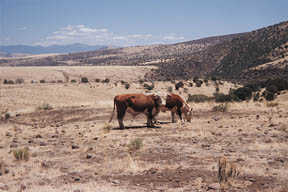|
|
|
Abe and Lydia Martinez have spent more than a half century creating,
building and maintaining a center of life for themselves, their
domestic livestock and wildlife for miles around their deeded
land and Forest Service allotment on the San Francisco River.
Twenty-two miles east of Clifton, Ariz., Abe and Lydia have been
on the ranch since 1948. Their expertise stems from knowing the
land, its strengths and weaknesses. They know what their land
needs to be healthy and sustainable.
“I scattered the cattle by developing our water,” Abe explained,
as we made our way up the mountain to see the condition of his
Forest Service allotment. “At one time they had a lot of cattle
here and it hurt the country because they weren’t able to spread
the cattle out. I could see that when I came here, so I developed
water way up high where there’s a lot of grass. I also kept cattle
out of the lower country when the grass was growing. My belief
is to protect anything that’s hurting during the rainy season.
Once the grass grows and matures, it produces seeds and roots
to hold the soil.”
Over the years, Martinez built 26 water storage tanks in various
sections of the ranch and with that water development, wildlife
numbers and diversity have increased dramatically. “That’s one
thing people don’t seem to understand,” he said. “We wouldn’t
have half the wildlife around here without the stock tanks.”
It costs between $5,000 and $8,000 to build each of the stock
tanks on the ranch, more if a well needs to be drilled. Martinez
wonders aloud, “Who will be there to make sure the wildlife has
water when the ranchers are pushed off the land?”
The Martinez Ranch covers a wide variety of land. From the Forest
Service allotment on the ranch’s southern mountains to the 140
acres of deeded land in the valley below, it’s the last working
ranch on this stretch of the San Francisco River. Their neighbors
on the river have long since been forced out of ranching for one
reason or another. Ultimately, these lands have made their way
off the tax rolls and into the possession of the Forest Service
through the federal land exchange process.
Monitoring the range is another important part of management on
the Martinez Ranch. Each year the ranch monitors 60 different
stations on the 23 sections of the allotment. Using Forest Service
criteria to assess the condition of the range, the data indicates
that his 23-square-mile allotment should be able to graze 317
head of cattle. Amazingly, the Forest Services will not accept
this data.
“We’ve used (Forest Service) specifications and their own scales,”
Martinez said. “We went to them every time we monitored, but it
turned out that they just didn’t want to accept the scientific
data. Instead, they wanted me to make some kind of a proposition.
Their own criteria said this country would run 317 head, so I
proposed to leave it at the 250 head–what we’ve been running since
we’ve been here. And that’s where it stands. We’re still in the
process. They’re even telling us that because of the pressure
[from environmental groups], they need to cut cattle numbers in
this country regardless of the scientific data or what they see
on the range.”
Martinez underscores the hypocrisy when it comes to range management.
When it comes down to it, what have they actually done for the
land? Nothing, he says.
“These people who call themselves environmentalists get together
and sue the Forest Service for not doing this and not doing that,”
he said. “It’s our tax dollars that reward them for doing it.
They don’t care if a lawsuit is substantial or not. Why? Because
bureaucrats push through regulations that are unrealistic and
unworkable in the first place. That’s the main thing. Too much
regulation from people who really don’t know what’s going on.
You sure don’t see those Forest Guardians up here learning what’s
really happening on the ground.”
Martinez doesn’t believe the Forest Service will be able to take
care of any of the improvements on the range. “They will all just
go away,” he said. “It’s not just the cattle, but the birds, deer
and wildlife that will go away, too. Ranchers are the reason why
there’s so much wildlife in rural Arizona. These so-called environmentalists
think that elimination of the range manager will be a good thing,
when in reality it will be quite the opposite. No water for wildlife,
no supervision of hunters, hikers and nobody to take care of the
trash urban Arizonans bring into the national forests. Do you
think the Forest Service is going to take on that responsibility?”
Mike Shirra is director of communications and marketing for the
Arizona Beef Council and the Arizona Cattlemen’s Association.
|
|
|
|


